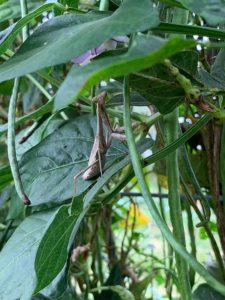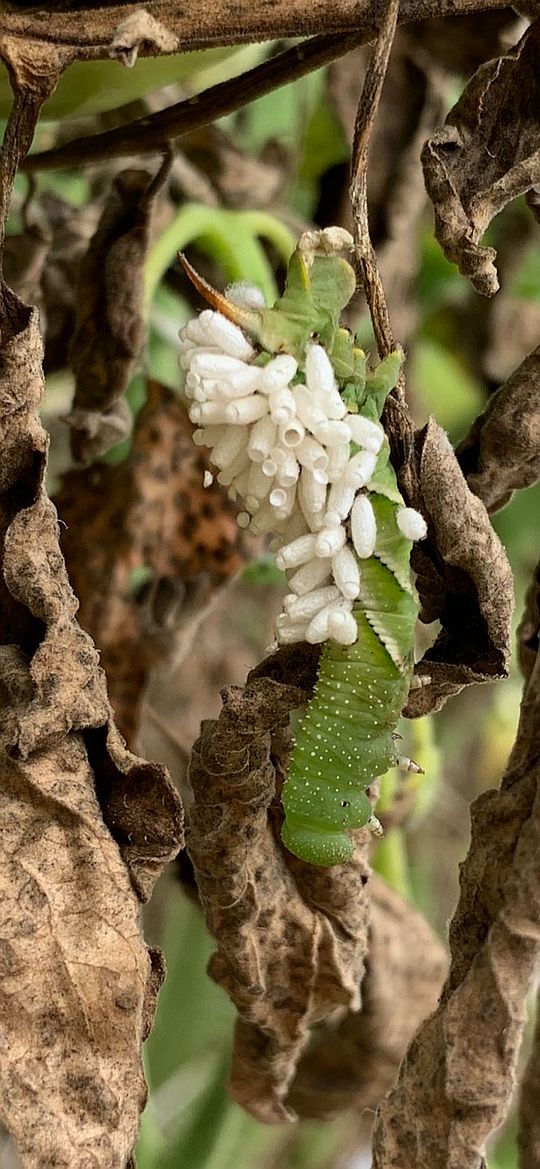Some very small helpers

I came across some creatures while harvesting today and that got me thinking about pest management. While I was picking the long beans I saw two praying mantises. I don’t often see mantises in the field, so it was a real treat. How many more where there that I did not even see? Young mantises eat soft bodied insects like caterpillars and aphids. Adults also eat beetles, grasshoppers and crickets.
Later, in the tomatoes, I saw a dead hornworm that had been killed by teeny tiny parasitic braconid wasps. The hornworms are pests, they grow as large as your index finger and take big bites out of tomatoes and can defoliate entire plants. Bear with me, because this next part is pretty gross. Upon finding a tomato hornworm, the female braconid wasp lays her eggs through the caterpillar’s soft skin. At the same time, she injects a virus that disables the caterpillars immune response. The wasp larvae then grow and feed inside the caterpillars body. When they are ready to pupate, they chew their way out of the caterpillar and spin cocoons that are attached to the caterpillar’s body. The tiny wasps emerge from their cocoons and the caterpillar soon dies.
Pests are part of the eco-system
Mantises and braconid wasps are just two of the many beneficial insects hard at work on the farm. We have lady bugs that eat aphids and eggs of pest species. There are lacewings and assassin bugs. Although they are not insects, frogs, toads and birds are out here doing the good work as well. This illustrates an important part of integrated pest management: predatory insects need a population of pests to feed on. If you eliminate all the pests, you starve your beneficial insects. We aren’t waging war on our insect pests, or trying to wipe them off the face of our farm. This is a natural system. That why we talk about managing insect pests instead of controlling pests.
An ounce of prevention
Let me take a step back before I over-romanticize what is going on out here. Sometimes we do step in and kill (or try to kill) insect pests by spraying an organic insecticide. But most of what we do in pest management is preventative. For some crops we physically exclude pests by covering turnips (root fly) and young squash (cucumber beetles). We keep things mowed and weeded and turn all our crop residue under in the fall to control squash bugs and stink bugs by removing their preferred habitat. And then we are always scouting the field, looking for pest damage. We might find a slightly higher level of damage acceptable, because we are always weighing the benefit of applying a pesticide against the cost of disrupting the natural system. In addition to the beneficial insects that eat the bad bugs, we also have pollinators to think about. Of course we think of honeybees, but there are a whole host of native bee species out there pollinating, along with flies, wasps, and other insects. They are out there working for us just by going about their lives. So we try to let them.
Full Shares
- Crunchy King Radishes*
- Red Russian Kale
- Collards
- Okra
- Long Beans
- Butternut Squash
- Sweet Peppers
Small Shares
- Crunchy King Radishes*
- Red Russian Kale
- Faux Collards (Broccoli or Cauliflower Greens – use as collards)
- Okra
- Eggplant
- Butternut Squash
- Sweet Peppers
* It’s been HOT and therefor the radishes are HOT as well. If you prefer radishes that don’t bite back, try sauteing or roasting these. Cooking mellows the flavor. You can cook and eat the greens as well.




You must be logged in to post a comment.